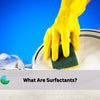Hard Water Stains in Your Toilet Bowl? Here's a solution How to Clean Them
- by Brodie Cook
Do you have ugly yellow, brown, or red stains in your toilet bowl? These stains can make your white porcelain look dirty and unhealthy, even if you clean it often. Most of the time, these stains come from hard water, which has a lot of minerals like calcium and magnesium. Over time, these minerals build up and stick to your toilet bowl, making it hard to clean with just a brush and regular cleaner.
It's important to keep your toilet bowl clean and stain-free for many reasons, including preventing clogs in the drain. First, a dirty toilet can spread germs and bacteria that's unhealthy. Second, stains can damage your toilet and cause problems with your pipes if you don't remove them. Lastly, a clean and shiny toilet just looks and feels better to use! In this article, we'll show you some easy and effective ways to get rid of those stubborn toilet bowl stains using natural ingredients you probably already have at home.
Identifying Types of Toilet Bowl Stains

Before you start cleaning your toilet bowl, it's a good idea to figure out what kind of stains you have. Different types of stains need different cleaning methods. Here are some common types of toilet bowl stains and how to spot them:
- Hard water stains: These stains are yellow or off-white in colour. They happen when minerals like calcium and magnesium in hard water build up in your toilet bowl over time.
- Copper stains: If you see blue stains in your toilet bowl, they might be caused by copper. This can happen if you have copper pipes or if there is acid in your water.
- Rust stains: Rust stains are red or brown in colour. They happen when there is iron in your water that reacts with oxygen and leaves a reddish-brown mark on your toilet bowl.
- Mould stains: Mold stains are black or dark green and often have a musty smell. Mould likes to grow in damp and moist places, so it's common to find it in toilets.
- Pink stains: Pink stains are caused by a type of bacteria called Serratia marcescens. This bacteria feeds on minerals, moisture, and dust particles and can be bad for your health if you don't clean it.
Once you know what type of stains you have, you can choose the best cleaning method to get rid of them.
Remove Hard Water Stains the Easy Way
Lucent Globe Toilet Cleaning Sheets dissolve fast to break down hard water stains and mineral build-up. No bleach, no fumes, just a clean, fresh toilet bowl that’s safe for your pipes and septic system.
Shop Toilet Cleaning SheetsTools and Solutions for Cleaning Toilet Bowl Stains

Before you start cleaning your toilet bowl and make it shine again, make sure you have the right tools and solutions. Here's what you'll need:
- Rubber gloves: Always wear rubber gloves to protect your hands from germs and cleaning solutions.
- Face mask: Wearing a face mask can help protect you from breathing in any harmful fumes or bacteria.
- Toilet brush: A good toilet brush is a must-have for scrubbing away stains and grime.
When it comes to cleaning solutions, you have a few options. You can use natural ingredients that you might already have at home, like:
- Baking soda: This is a gentle abrasive that can help scrub away stains.
- White vinegar: The acid in vinegar is great for breaking down mineral deposits and killing bacteria.
- Lemon juice: Like vinegar, lemon juice is acidic and can help remove stains.
- Hydrogen peroxide: This is a natural bleach alternative that can whiten and disinfect your toilet bowl.
- Borax: Borax is a mineral that's great for tough stains and hard water deposits.
- Citric acid: Citric acid is a strong natural cleaner that can tackle even the toughest hard water stains.
If you prefer to use a commercial cleaning product, look for something that is biodegradable and effective. One great option is our new Toilet Cleaning Sheets. These sheets are powerful enough to clean your toilet bowl without harsh chemicals. They're also safe for septic systems and greywater. Plus, each pack comes with 30 sheets, so they'll last you a while. Just drop a sheet in your toilet bowl, let it work its magic, then brush and flush for a sparkling clean toilet.
Cleaning Methods for Different Stain Types
Now that you know what kind of stains you have and what tools and solutions you need, let's look at some step-by-step methods for cleaning them.
Hard Water and Mould Stains:
-
- Lemon juice and water solution: Mix equal parts lemon juice and water in a spray bottle. Spray the solution on the stains and let it sit for 20-30 minutes. Then scrub with a toilet brush and flush.
-
- Vinegar and baking soda paste: Sprinkle baking soda on the stains and let it sit for 10 minutes. Then pour white vinegar over the baking soda and scrub with a brush. The mixture will fizz and bubble, helping to lift the stains. Let it sit for 30 minutes, then flush.
- Borax and vinegar paste: Mix 2 tablespoons of white vinegar with 1/2 cup of borax to make a paste. Spread the paste on the stains and let it sit for 20 minutes. Then scrub and flush.
Rust and Copper Stains:
-
- Hydrogen peroxide and baking soda solution: Pour 1/2 cup of hydrogen peroxide into the toilet bowl and scrub the stains. Let it sit for 30 minutes, then sprinkle baking soda over the hydrogen peroxide. Wait 10 more minutes, then scrub again and flush.
Stubborn Stains:
-
- Citric acid overnight treatment: For tough stains that won't come off with other methods, try using citric acid. Pour a small amount of warm water into the toilet bowl, just enough to cover the stains. Then add about 3 tablespoons of citric acid and stir it into the water. Let the mixture sit overnight, then scrub the stains with a toilet brush and flush. Repeat if necessary.
Remember to always wear gloves and a mask when cleaning your toilet, and never mix different cleaning products together as this can create dangerous fumes. With these simple methods, you can get rid of even the most stubborn toilet bowl stains and keep your bathroom looking and smelling fresh.
Maintenance and Prevention Tips
Maintaining your toilet bowl by cleaning regularly is the best way to prevent stains from building up. Try to clean your toilet at least once a week, using a brush and our toilet cleaning sheet.
If you have hard water, you may want to install a water filter to remove some of the minerals, as this is a significant factor in causing stains. You can also check your pipes regularly for signs of corrosion or leaks, which can lead to rust or copper stains in your toilet bowl. Finally, make sure to keep your bathroom well-ventilated by opening a window or running a fan after showers or baths. This will help prevent mould and mildew from growing in your toilet bowl and other damp areas.
When to Seek Professional Help to Clean Your Toilet
If you've been cleaning your toilet bowl regularly but still notice persistent stains, it may be time to call in a professional. Some types of stains, like those caused by hard water or mineral buildup, can be very difficult to remove with regular cleaning methods. A professional plumber or cleaning service will have special tools and products that can tackle even the toughest stains.
Another reason to seek professional help is if you suspect that your pipes are corroded or leaking. If you notice rust or copper stains in your toilet bowl that won't go away with cleaning, it could be a sign of a more serious problem with your plumbing. A plumber can inspect your pipes and make any necessary repairs to prevent further damage and staining. Finally, if you simply don't have the time or energy to keep up with regular toilet bowl cleaning, you may want to consider hiring a professional cleaning service to do a deep clean every few months. This can help keep your toilet bowl looking its best and prevent stains from building up over time.
FAQ About How to Clean a Toilet That is Stained
How can I effectively remove hard water stains from my toilet bowl in an eco-friendly manner?
You can use a mixture of white vinegar and baking soda to scrub away hard water stains. Let it sit for a few minutes before scrubbing and flushing. For better results, use a citric acid solution to help break down the mineral deposits. This step will help to eliminate tough residue effectively.
Alternatively, use our toilet bowl sheets which have less impact on the environment. We do not recommend the use of harmful chemicals due to the impact it has on the environment and there are better and more ways to remove hard water stains.
Can I prevent hard water stains from forming in my toilet bowl?
You can prevent hard water stains by regularly cleaning your toilet bowl with a cleaner specifically designed to combat hard water build-up. Maintaining a cleaning routine is key. Additionally, consider installing a water filter on your water supply to reduce mineral content, which is a common issue.
How often should I clean my toilet bowl to prevent hard water stains?
It is recommended to clean your toilet bowl at least once per two weeks to prevent hard water stains and maintain overall cleanliness. Regular cleaning also helps to prevent bigger issues like fungus and bad odours.

 Dishwashing
Dishwashing Laundry
Laundry Bundles
Bundles Surfaces
Surfaces Toilet
Toilet Handsoap
Handsoap Multi-Purpose
Multi-Purpose Floor
Floor






